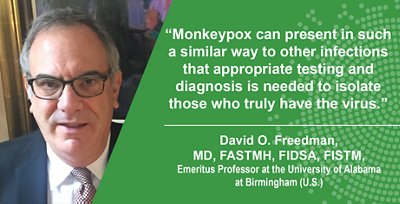What We Know About Monkeypox and Diagnostics
By the bioMérieux Editors | Reading time: 2 min
PUBLICATION DATE : OCTOBER 11, 2022
On July 23, 2022, the World Health Organization (WHO) declared Monkeypox a public health emergency. While this virus been observed in human populations mainly in West or Central Africa since the 1970s, the larger geographic scale of the recent outbreak has caused elevated concern. As of September 2022, over 62,000 confirmed and suspected cases have been reported worldwide, the majority of which have been identified among men who have sex with men (MSM), although other populations are also able to be infected.
bioMérieux discussed the current status of the Monkeypox response from a diagnostic perspective with David O. Freedman, MD, FASTMH, FIDSA, FISTM, Emeritus Professor at the University of Alabama at Birmingham (U.S.)
Clinical Identification and Laboratory Processing
According to the WHO, Monkeypox is transmitted through close contact with an infected person or with material contaminated with the virus, and infection typically presents with fever, rashes, swollen lymph nodes and skin lesions. Vaccination against smallpox has been shown to provide some protection against Monkeypox, and more targeting vaccines are being developed and approved.
The Monkeypox virus presents a few unique challenges in terms of how it is transmitted and how it is diagnosed. It is currently unclear whether the virus acts like a typical sexually transmitted infection (STI), like herpes, or if the transmission by close contact is such that it is by nature related to sexual contact. Isolated lesions in the mouth or anus are difficult to characterize and diagnosis during a quick physical screening examination.
Because different public health authorities gave different advice early in the recent outbreak, there remains some question as to which guidelines to follow and which are up to date. Current recommendations are to vigorously swab the lesion without disinfecting or deroofing the sore and to transport the sample in a dry tube without a transportation medium. Samples must be shipped frozen when sent to a public health lab for diagnosis.
PCR testing can detect non-variola orthopoxviruses like Monkeypox, but positive tests should still be sent to the governing authority for definite confirmation and recording. Large teaching hospitals likely already have the capacity for in-house PCR testing, but time and effort are still needed to make kits, follow protocols and validate results.

Infection Prevention and Public Health
Countries that have not initiated a significant public health response to Monkeypox will likely not have the increased laboratory testing capacity needed to meet rising demand. Furthermore, as a result of the relatively rapid response to the COVID-19 pandemic, the public may have higher expectations than before for the speed at which new tools are authorized for public use. More resources are needed for data collection in order to identify and monitor the spread of Monkeypox to inform public health actions.
Monkeypox can present in such a similar way to other infections that appropriate testing and diagnosis is needed to isolate those who truly have the virus. Access to the correct diagnostics would enable the immediate isolation of those with milder lesions that are difficult to empirically verify. Diagnostics could also assist in organizing future vaccine rollouts. Regular sampling of risk populations broadly, as well as clusters of skin rash cases when they occur, could identify community outbreaks in order to inform vaccine efforts.
Increased access to, and effective use of, the necessary diagnostics could play a key role in directing patient care for suspected cases of Monkeypox while simultaneously informing infection prevention and control measures at a public health level.
Opinion expressed in this article are not necessarily those of bioMérieux.
SHARE THIS:
- Infectious Diseases
- Expert Opinion
< SWIPE FOR MORE ARTICLES >